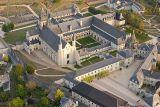This is the second part of the talk Bruce MacCarthy gave at the general meeting of the New South Wales Branch on 8 February 2014.
Fontevraud Abbey is where Henry II, Eleanor of Aquitaine, Richard Coeur de Lion and Isabella of Angouleme were buried. Today, within the abbey church one can see their recumbent effigies, though their bodies are no longer there.
The Abbey is located in the Pays de la Loire region, approximately 65 km south east of Angers, and about 300 km south west of Paris – 3- 4 hours of driving from Paris (longer if you are cautious about driving on the right hand side of the road.) It was considered one of the greatest monastic cities in medieval Europe. The Abbey is impressive both in its size and its originality.
The Order of Fontevraud was founded around the turn of the 12th century by Robert of Arbrissel, an itinerant reforming preacher. The first permanent structures were built between 1110 and 1119. There was a group of monasteries. Saint Marie housed nuns and Saint Lazar housed lepers; Saint Benoit was for the sick and La Madeleine was for “fallen women.” Saint Jean l’Habit housed monks. Interestingly, given the dominance of men in those days, the overall community was managed by an abbess, as had been decreed by the founder, and it became a refuge for women from noble families, especially repudiated queens and daughters of royal and aristocratic lineage.
 General view of Fontevraud Abbey (photograph by Pierre Mairé, obtained under the Creative Commons Attribution-Share Alike 3.0 Unported license)
General view of Fontevraud Abbey (photograph by Pierre Mairé, obtained under the Creative Commons Attribution-Share Alike 3.0 Unported license)
The counts of Anjou had supported the Abbey over the years. Indeed, one of Henry II’s aunts was Abbess there. Over the years there were numerous noble abbesses, including members of the Bourbon family.
Given his family long association with the Abbey, it was not surprising that Henry II was buried there after he died in France. Richard also died in France, and his request to be buried at the feet of his father was honoured. Eleanor retired to the Abbey and became a nun. When she died, she was buried beside her late husband. Although John died and was buried in England, his son Henry III apparently crossed to France to witness the burial of his mother Isabella at the Abbey. Later, his heart and the heart of John were buried at the Abbey.
With the fall of the Angevin empire, the fortunes of the Abbey suffered. While it was protected by the Bourbon family during the religious wars of the 16th century, its life as a functioning Abbey ended during the French Revolution.
Following a Revolutionary decree in August 1792 which ordered the evacuation of all monasteries, and the Order of Fontevraud was dissolved. The last abbess a Madame d’Antin, died in Paris in poverty. The Abbey was pillaged by revolutionaries in 1793 and the Royal tombs were desecrated. As far as I am aware, no one knows exactly what happened to the bodies of the Angevins, but fortunately the effigies remain to this day, as I saw to my delight in October 2010.
Prison
The decision by Napoleon to transform the Abbey into a prison in 1804, saved it from destruction. It remained a penal institution from 1804 until 1963 but, as prisoners were used as labourers on the transition from penal facility to its former life as a monastery, the very last prisoners left Fontevraud as recently as 1985.
Cultural Encounter Centre
The Abbey of Fontevraud is the icon for the UNESCO World Heritage Site of Val de Loire. Today, as a “Cultural Encounter Centre,” the Abbey is a renowned site for concerts, symposiums and exhibitions. It also plays a role in creative development thanks to artists’ residencies that are welcomed by the abbey.
On offer at the Abbey is a range of thematic visits off the beaten path that can be shared with the whole family: “The underground passages”, “The last days of the Abbey: before the Revolution”, “The Central prison ” and also “The nuns’ daily life”.
Having been a monastic town for seven centuries, the Abbey of Fontevraud has an architectural style rich in terms of spiritual meaning but also punctuated by the manual activities, which were part of everyday life there. One can walk in the footsteps of the nuns, and explore the Roman kitchens, the cloisters, the dormitories and the large refectory. It was in the process of being restored when I was there and no doubt it is now in even better shape than it was four years ago.
Staying there
For those who have always dreamt of sleeping in an abbey, the “Hotel du Prieuré Saint Lazare” offers 52 rooms. Ours was a comfortable ensuite room overlooking an orchard.
The hotel has mod cons like Wifi, and the gastronomic “Saint Lazare” restaurant. Guests at the hotel are free to enjoy the site and amble around the gardens.
There is so much to see at Fontevraud, that one could spend days wandering around the Abbey and the surrounding town. I commend it to you as a “must see” visit on any trip to France.
Tags: Eleanor of Aquitaine, France, Henry II, Richard I
 Death of Louis XI from a stroke. He was succeeded by his son Charles VIII, who was only 13 at the time. Charles’ eldest sister Anne acted as regent.
Death of Louis XI from a stroke. He was succeeded by his son Charles VIII, who was only 13 at the time. Charles’ eldest sister Anne acted as regent.


